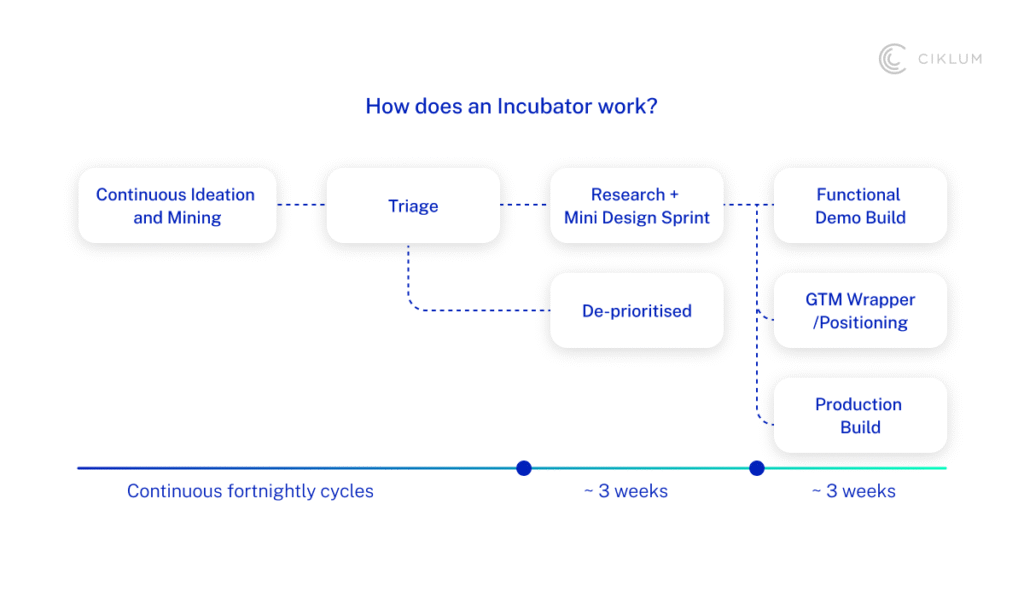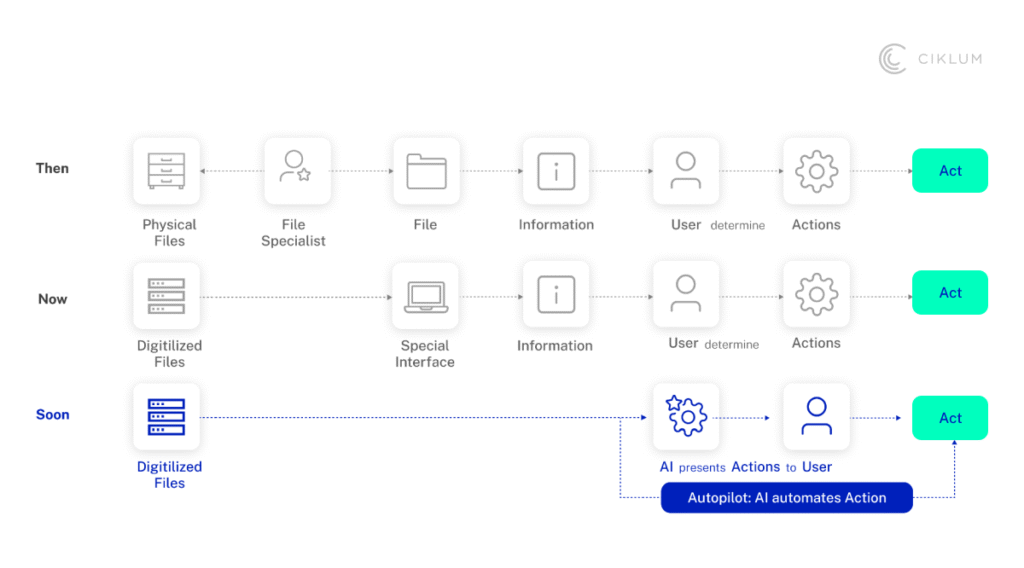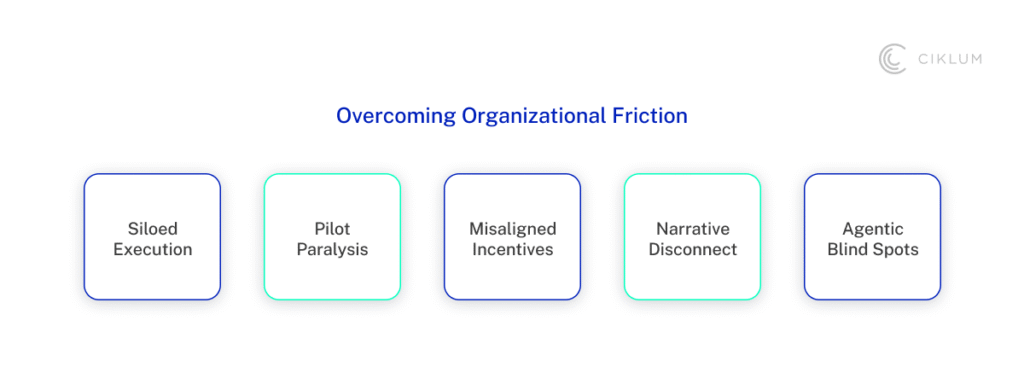Key Takeaways:
- 95% of AI pilots fail to scale into business value.
- AI must be deeply embedded in business operations.
- Boost.ai’s hybrid model balances precision, flexibility, and autonomy.
- Moving beyond pilots requires building a clear, confident roadmap.
AI at Crossroads
AI initiatives across industries are hitting a wall. Despite pouring millions into proofs of concept, nearly 95% of generative AI pilots fail to scale, leaving companies stuck in a cycle of unrealized promises. Most projects remain stuck in “pilot purgatory”, which refers to the phase where AI projects get caught in a continuous loop of testing and small-scale trials due to a lack of clear strategy or leadership buy-in.
Boardrooms are now divided between two major concerns. On one side, there is fear of missing out on AI-driven productivity and customer experience. On the other hand, there is fear of getting it wrong, with compliance failures and wasted capital. In most cases, the fear of failure outweighs the fear of missing out, and it’s this hesitation that keeps AI from reaching its full potential.

Turning AI into a Business Foundation
The companies that succeed with AI treat it as a foundational element of their business operations, not just a one-off project. This involves embedding AI deeply into customer journeys, ensuring it’s integrated with critical business systems, and governing it with the same rigor as other enterprise functions like finance and HR.
At the Ciklum Client Conference in Prague, senior executives from Boost.ai, Anne Cecilie Ekern and Jens Steno, joined us to share how this shift from pilot to production looks in practice. Together, we uncovered why so many pilots stall, how to avoid the common pitfalls, and what a two-year roadmap to ROI really requires.

The Pitfalls That Derail AI Initiatives
Why do so many projects look promising on paper but never deliver ROI for the business? From Ciklum’s perspective, five recurring pitfalls explain why AI programs fail to scale and create value.
No Channel Strategy
Many enterprises start small, launching AI in a single isolated channel such as web chat. But without a clear strategy to scale across other channels like voice, mobile, or social, AI becomes fragmented, and customer experience suffers.
Lack of Integration with Core Systems
An AI agent without the ability to integrate with critical business systems like billing, CRM, or booking platforms is just a glorified search tool. It can respond to queries but lacks the actionability required to truly serve customers. Without these integrations, AI struggles to resolve issues and limits the AI’s potential to drive results.
Weak Change Management
AI is often introduced as a “bolt-on” technology, a quick fix to existing processes, without bringing internal stakeholders along for the ride. This way, employees perceive AI as a threat to their jobs rather than an enabler of their work.
Compliance Blind Spots
With regulations like GDPR and the EU AI Act, compliance can no longer be considered optional. AI projects that fail to consider compliance requirements from the start often face intervention from legal teams late in the process, leading to delays or even outright cancellations.
Misjudged Scope
Projects that start too small, such as answering only a handful of FAQs, fail to show tangible value. Overly ambitious projects collapse under their own weight. Getting the scope right from the beginning is essential to building credibility and momentum for long-term success.
Hybrid Approach For Sustainable Success
For years, enterprises have faced a false choice between rule-based bots and generative AI. The former offers predictability but can feel rigid and limited, while the latter brings dynamism at the cost of potential risks, such as compliance breaches. Neither approach alone delivers the scale, control, and resilience that large organizations need.
Boost.ai’s hybrid model bridges this gap by combining three complementary layers of capability:
- Rule-based precision for compliance-sensitive transactions, ensuring zero tolerance for errors.
- Generative flexibility that provides real-time conversational flow and adaptation to customer needs.
- Agentic autonomy that enables AI to plan, act, and collaborate across systems, turning knowledge into end-to-end outcomes.
In this model, risks such as hallucinations are mitigated by structuring knowledge into topic-specific buckets and complemented by both global and local guardrails that ensure AI operates within defined boundaries.
At Ciklum, we ensure this hybrid capability is embedded within a broader operating model, aligning it with business goals, compliance requirements, and change management processes. Only by doing this does hybrid AI transform from a clever feature into a true growth engine for enterprises.
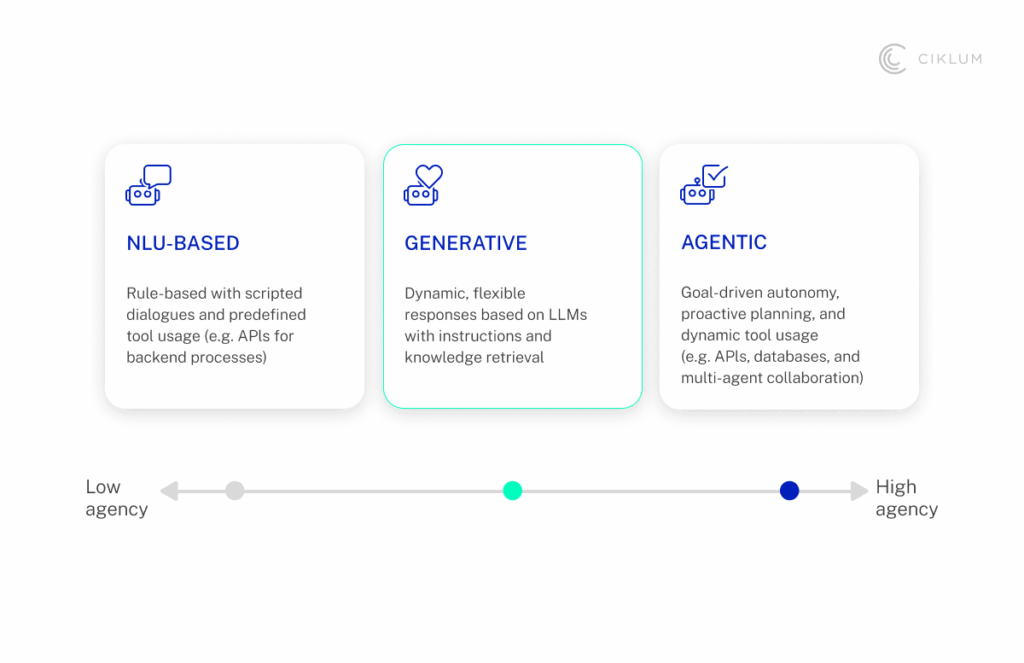
The Success Formula for Conversational AI
Enterprises that succeed with conversational AI run it like a core business capability. From our session with Boost.ai, five themes consistently separated leaders who scaled successfully from those stuck in pilots.
Customer-First Design
The best AI initiatives begin with empathy. Enterprises should prioritize creating experiences that customers actually trust, starting with natural language understanding and user-centric flows that reduce frustration.
Automation Through Integration
Impact is not measured by the number of conversations started but by the number resolved without human input. Value emerges when AI integrates with billing systems, CRMs, and booking engines, allowing it to act rather than just answer.
Commercial Impact
AI is not just about cost savings. When executed well, it also recommends, upsells, and creates new revenue streams. Success means measuring both efficiency gains and topline growth.
Trust and Governance From Day One
Security, compliance, and governance cannot be bolted on later. GDPR, the EU AI Act, and other regulations must be embedded from the start to prevent costly delays and ensure AI projects are legally sound.
Iterative Growth and Ownership
The best outcomes come from an ongoing cycle of build, test, analyze, and optimize. Successful organizations empower internal teams to adapt and evolve AI quickly, with minimal reliance on IT, ensuring scalability and long-term success.
Together, these five elements form a practical blueprint for scaling conversational AI into a true enterprise capability.
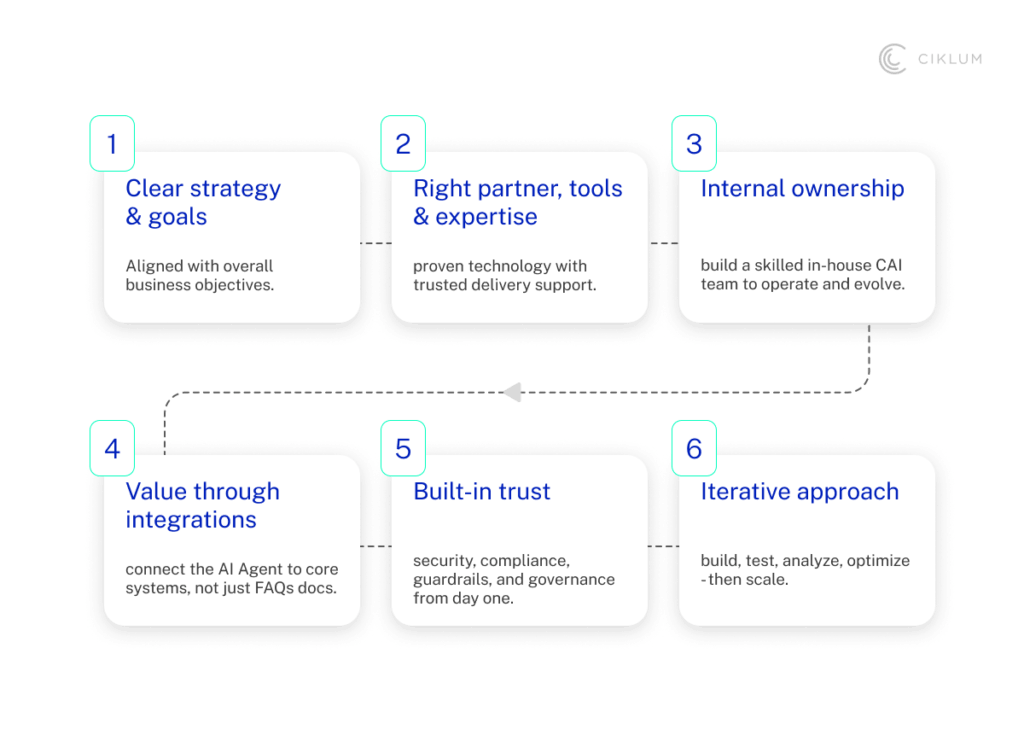
The Executive Roadmap: From 3 Months to 2 Years
One of the most common questions executives ask is: “When will this deliver value?” The answer depends on where you start, but the trajectory follows a clear pattern.
- First 3 months: Enterprises see quick wins, with more than 40% of chat inquiries automated. Wait times drop down and contact-center volumes shrink.
- 9 months: Automation surpasses 60% across chat. Customer satisfaction scores rise as experiences become faster and more consistent.
- 18–21 months: More than 50% of all inquiries, including chat and voice, are handled by AI. This is the point where scaling accelerates and momentum becomes self-sustaining.
- 2 years: AI agents generate more than 3x ROI compared to cost. Enterprises not only save but also create new revenue opportunities.
Not every journey will follow this exact curve. But with the right partner ecosystem and operating model, conversational AI compounds value over time instead of stalling at the pilot phase.
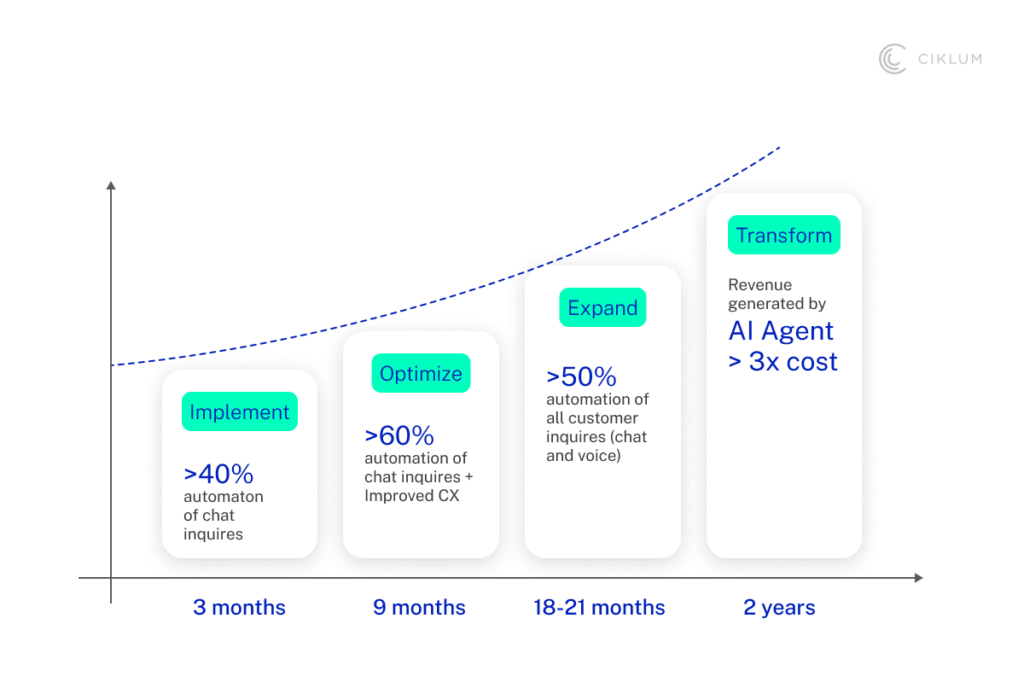
The Takeaway: Turning AI Hype into Tangible Business Outcomes
As the 10th anniversary of the Ciklum Client Conference came to a close, one key theme emerged from the discussions. Too many enterprises still treat conversational AI as a temporary experiment, rather than a strategic asset. The companies that truly succeed with AI embed it at the core of their business operations. They integrate AI into their DNA, from customer journeys to critical business systems.
At Ciklum, we combine our strategic expertise in experience engineering with Boost.ai’s enterprise-grade platform. Together, we are trusted partners on your CX automation journey, helping enterprises move beyond pilots and unlock real impact in the form of lower costs, faster resolution times, happier customers, and new revenue streams.
Get in touch with us to learn how Ciklum can help you turn conversational AI into a growth engine for your business.































